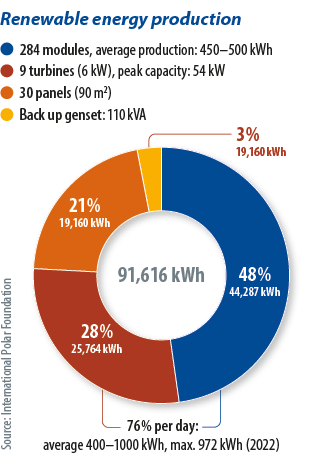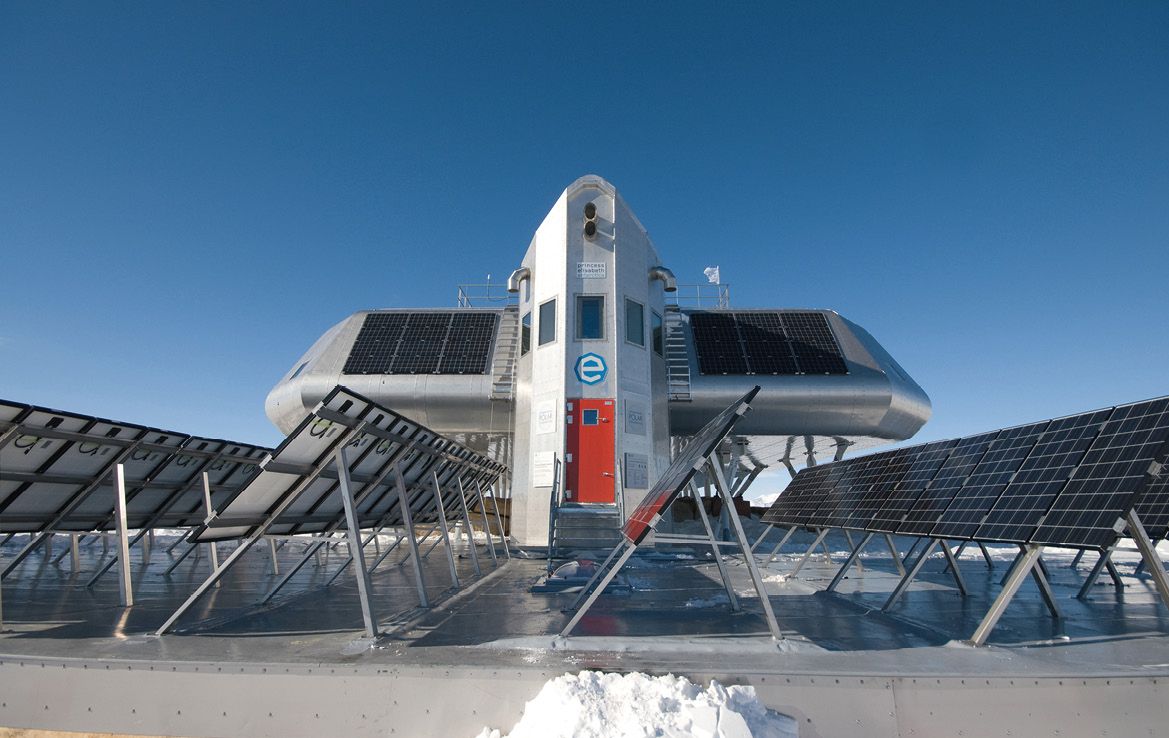From pv magazine ISSUE 06/23
The first-ever zero-emission polar research station, Princess Elisabeth Antarctica, has successfully continued its science mission with a recent solar upgrade. The station, established and constructed by the International Polar Foundation in collaboration with partners including the Belgian state, between 2007-09, continues to showcase forward-thinking sustainable design.
The base is occupied by scientists during the summer and benefits from approximately 100 days of 24-hour daylight, which provides an unusually abundant resource. Moreover, bifacial PV modules are employed at the station, with some of the best conditions for reflected irradiance in the world keenly exploited.
 Most of the station’s power is sourced from photovoltaic and solar thermal systems as well as wind turbines. Classic lead-acid batteries are used for energy storage, providing 438 kWh, of which 260 kWh is considered usable under ideal conditions. The station consumes approximately 10 kW to 20 kW during the active season, which means its energy storage capacity can last for 13 hours to 26 hours in the absence of sun or wind. Additionally, a backup generator is present for security purposes.
Most of the station’s power is sourced from photovoltaic and solar thermal systems as well as wind turbines. Classic lead-acid batteries are used for energy storage, providing 438 kWh, of which 260 kWh is considered usable under ideal conditions. The station consumes approximately 10 kW to 20 kW during the active season, which means its energy storage capacity can last for 13 hours to 26 hours in the absence of sun or wind. Additionally, a backup generator is present for security purposes.
The engineering team plans to install hydrogen fuel cells as a backup energy system. In a presentation he gave at the EU’s annual Green Week, Alain Hubert, founder of the Brussels-based International Polar Foundation, Belgian polar explorer, and engineer, explained that the energy production breakdown across a year consists of 48% from PV, 21% from solar thermal, and 28% from wind turbines. During the winter, modules are protected with wooden panels.
Remarkably, the generator accounts for only 3% of the energy consumed and is used primarily during maintenance periods. Katabatic winds blow throughout both summer and winter seasons, with nine 6 kW turbines generating power. The highest recorded energy generation at the site was 972 kWh, in 2022.
PV expansion
This Antarctic season, an additional 22 kW of photovoltaic generation capacity will be added to the station using Bisol modules. Bisol, a Slovenian module maker, reported that 48 out of the 60 modules required for the project have been installed and the remaining 12 panels will be added during the 2023-24 austral summer research season, which runs from October to March.
Guus Luppens, an engineer who works with the International Polar Foundation and is part of the renewable energy and microgrid team, explains that the extra panels were added with the unique objective of harvesting more power between midnight and 7 a.m.
“It’s difficult to determine the exact capacity connected to the station as we have yet to decide on the connection method,” says Luppens. “The additional (east-facing) solar panels were not installed solely for increased production but rather to address the low production levels during that time of day. We were experiencing insufficient incoming power between midnight and 7 a.m., which led to the installation of east-facing solar panels. We added a total of 44 panels, each with a capacity of 380 Wp, resulting in a total of 16.72 kWp.”
The station’s micro smart grid is reputed to be the most efficient energy network in the world. The system employs industrial, programmable logic controllers (PLCs) and supervisory control and data acquisition for processing, interaction, and communication, enabling efficient management of intermittent power generation and demand. The PLCs monitor more than 2,000 points of energy production and consumption. With a satellite ground station in place, the station can also be remotely monitored and controlled during summer and winter.
Energy demands are prioritized based on time-of-day scenarios as well as general priorities. Safety and security take precedence, followed by station operations and science requirements. Entertainment and leisure activities have the lowest priority.
Inhabitants of the station are, therefore, forced to adapt to the available quantity and priority of energy. Additionally, users are required to first request energy before plugging in, by activating a switch located on a power socket and waiting for a system check and an indicator light to change from red to green.
This content is protected by copyright and may not be reused. If you want to cooperate with us and would like to reuse some of our content, please contact: editors@pv-magazine.com.









By submitting this form you agree to pv magazine using your data for the purposes of publishing your comment.
Your personal data will only be disclosed or otherwise transmitted to third parties for the purposes of spam filtering or if this is necessary for technical maintenance of the website. Any other transfer to third parties will not take place unless this is justified on the basis of applicable data protection regulations or if pv magazine is legally obliged to do so.
You may revoke this consent at any time with effect for the future, in which case your personal data will be deleted immediately. Otherwise, your data will be deleted if pv magazine has processed your request or the purpose of data storage is fulfilled.
Further information on data privacy can be found in our Data Protection Policy.